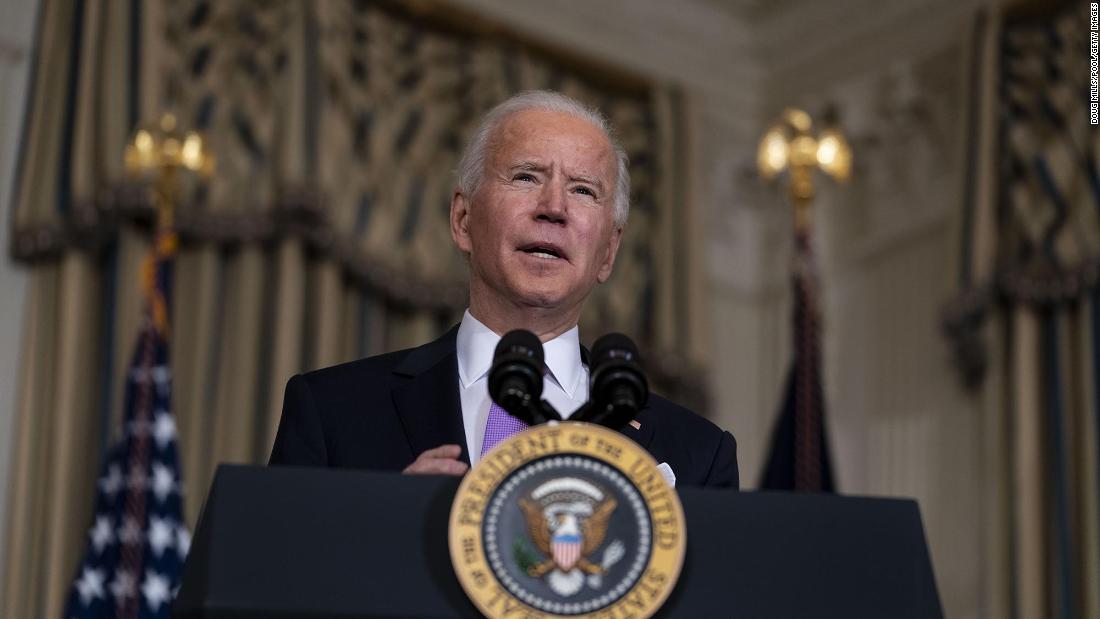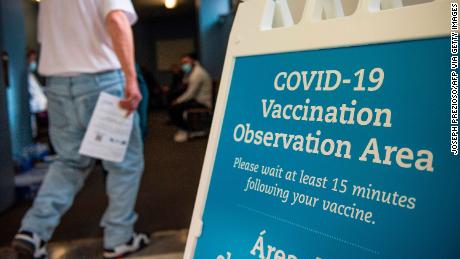The President pledged that there will be sufficient vaccines for 300 million Americans by the end of summer
In effect, the President is putting a date on a return of a semblance of normal life — with no guarantee that he can deliver.
If the President succeeds, Tuesday may be remembered as a key turning point in a pandemic exacerbated by the former Trump administration’s disastrous response. Should he fall short, the credibility of his new presidency will take a serious hit, that would not only prolong the crisis into another fall and winter but would also hamper his ambitious program on other key issues.
In a show of presidential power six days into his term, Biden sought to galvanize the action of federal, state and local governments into the kind of unified, national effort that had up until now been lacking during this once-in-century crisis.
“To a nation waiting for action, let me be clearest on this point: Help is on the way,” Biden said Tuesday, after announcing the purchase of another 200 million vaccine doses and a hike in distribution to states within days.
In some ways, Biden’s pledge included some political sleight of hand, since it will not get vaccine supply anywhere near levels demanded by the states in the short-term and he admitted deaths could hit half a million next month.
Tuesday’s announcement was both administrative and political.
It offered a rare morale boost after nearly a year of lockdowns, social distancing, separated families and sickness and death, especially coming in the darkest days of one of the grimmest winters in years.
“Let’s say we are able to get 300 million people vaccinated by the summer, life changes dramatically and we get out of this situation we are living in where the pandemic dominates our lives,” Dr. Ashish Jha, dean of the Brown University School of Public Health, said on CNN’s “The Situation Room.”
Signs that there is finally a federal government that is not in denial and has a coherent plan could give businesses, from cruise lines to restaurants, the capacity to plan ahead — a crucial factor in the recovery of the economy from its pandemic stasis.
And Biden’s aggressive, daily, actions designed to combat the pandemic since taking office may also inject a sense of urgency on Capitol Hill as Republicans question the need for a rescue package that is vital to speeding up vaccinations.
New White House seeks momentum
School closures have not only severely hampered the education of a generation of kids. They have complicated the lives of parents who struggle to work if they can’t access childcare. But the prospect of a return to class worries teachers unions — a strong force in the Democratic Party — amid concerns that especially older school staff are vulnerable to complications from the virus.
Signs of frenetic activity in the West Wing are already cheering governors used to inaccurate data and guidance from the Trump administration and who are pleading for more vaccine doses.
“You have a competent, professional, federal government that tells the truth,” New York Gov. Andrew Cuomo, who admittedly is, like Biden, a Democrat, told CNN’s Wolf Blitzer.
Zients also said that distribution to the states will increase by 16% by next week. It will become clear whether those calculations are accurate within days. And of course, even with a 16% increase, vaccine distribution will fall massively short of the number states need to make a dent in the crisis any time soon.
There has so far been no comment on Biden’s announcement of the purchase of 200 million more doses by Pfizer-BioNTech or Moderna, the two firms confirmed that have received emergency authorization for their vaccines.
Cleaning up the messaging
Biden’s announcement on Tuesday also represented some political triage, given some messy and sometimes conflicting messaging about targets and vaccine supply in recent days by the President and his staff.
While professing optimism on Tuesday, Biden was careful to temper expectations, warning: “We didn’t get into this mess overnight and it’s going to take months for us to turn things around.”
His comments reflected the political hazard inherent in setting timelines and making predictions about a pernicious and unpredictable pandemic, especially in the middle of a race between the mass deployment of vaccines and mutations of the virus that could challenge their effectiveness.
And Biden’s pledge, that follows criticism that his promise of 100 million administrated vaccine doses in his first 100 days was insufficiently ambitious, is also dependent on many other factors beyond his direct control.
Experience has shown that having vaccine available does not mean it is being administered. The White House argues however that its aggressive strategy is a huge improvement on the Trump team’s more hands-off approach that left the states to fix issues on their own. There may also be manufacturing glitches, potential supply and transport problems, and logistical issues in the states that could compromise the White House’s timeline, which could come back to haunt the President.
Then there is the issue of whether a sufficient proportion of Americans will get vaccinated for the country to approach herd immunity, the point at which it becomes difficult for the virus to spread. An Axios-Ipsos poll published on Tuesday showed that 49% of those asked intended to get the inoculation as soon as possible. Such data has led some top health experts in recent days to question whether at some point the key problem will not be a shortage of vaccines but a deficit of willing recipients.
“Day Seven: we have found a way to secure vaccine supply adequate to provide a dose for EVERY adult by summer,” White House Chief of Staff Ron Klain tweeted on Tuesday. “BUT that still leaves getting them all vaccinated — building the infrastructure, ending the hesitancy — as challenges.”
Those challenges recall the previous capacity of the virus to outrace local and federal government responses. Who could forget for instance Trump’s vow that the pews would be full in churches by last Easter? The new administration’s plans do seem on firmer ground and rooted in science. Trump’s pronouncements were based on wishful thinking, poor information and politically self-serving statements.
To back up the President’s promise to deploy science and not to hide bad news, the CDC and other experts are due to relaunch briefings at the White House on Wednesday.
There are also longer term challenges.
Despite the President’s daily admonitions that mask wearing could save tens of thousands of lives, the practice remains highly politicized, in a nation where a many conservatives believe conspiracy theories that he stole the election.
Should numbers of cases continue to fall, governors — especially those in Republican-run states — may prematurely reopen businesses at normal levels and trigger new waves of disease before Biden’s virus gambit fully delivers.
![]()




